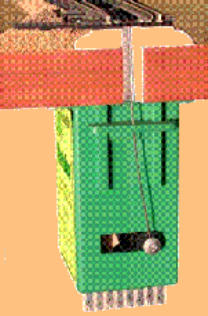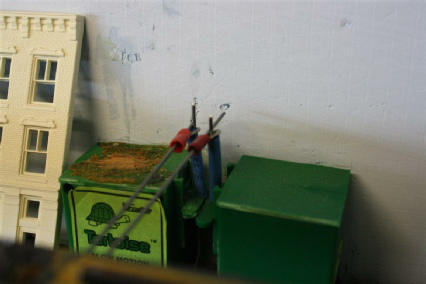Route of the Broadway LION

Route of the Broadway Lion, The largest Subway Layout in North Dakota
at Assumption Abbey, Richardton North Dakota
The Largest Subway Layout in North Dakota
The Lion and the Tortoise….
Tortoise Switch Machines are the new ‘standard’ for turnout
control. Unlike twin coil machines which require a momentary
pulse of power, these are powered by motors which draw a
constant current and simply stall out at when the switch is
thrown, keeping a snug fit between the switch rails and the
stock rails. They are easy to install, and even easier to wire.
1) The LION throws away the instructions and mounting templates. LION drills a
⅜” or even a ½” hole under the throw-bar before the switch is mounted.
2) The LION manually centers the actuator on the Tortoise, and then applies a
glob of silicone caulk to the flat mounting face of the Tortoise. Keep the caulk
away from the hole and the actuator wire.
3) Him then inserts the rod up through the hole in the table, and the hole in the
throw-bar.
4) LION moves the Tortoise gently until the switch points are also centered, the
Tortoise is perpendicular to the tracks and there is no north or south stress on the
actuator rod.
5) Hold it in place for a moment, or use a stick to prop it in place until the caulk
dries. This is usually not necessary unless you have already soldered wires to
the contacts, which is advised if you are mounting the Tortoise in a place where
soldering might be a problem.
Mounting a Tortoise someplace else…
Here the Tortoise switch machines are mounted on the back wall, the tracks are
on the elevated structure above the highway. The Tortoise machines will be
hidden by the facade of some buildings to be placed along the road. Motion is
transmitted between the Tortoise and the switch points by a length of 1/16” steel
welding wire.

These are the contacts that operate the Tortoise. LION
attaches one of these to the common GROUND bus wire
serving the layout. The other one is connected to the
control panel. If, with the control in the normal position
the switch is not aligned for the main line, then reverse
these two connectors.
The remaining contacts are a DPDT switch that can be
used to power the frog, control track power to diverging
routes, or operate signals.
Pins 4 and 5 are common.
If you really want the Tortoise instruction sheet,
you may download it here.




Below there is an array of yard tracks without any
access to the area directly below them.

Here I used a motor tool to mortise a ditch between the turnout and the
Tortoise. I pre-wired the Tortoise, glued it to the rear fascia with Silicone caulk,
and centered the actuator by hand.
I next fashioned the copper wire shown below. I wrapped it around a fine rod
and then placing it on the Tortoise, I also centered the switch points. I taped
them in place so that they would not move, and then I soldered the wire to the
steel throw rod that connects the movement to the throw-bar




- 242nd Street
- 121st Street
- Dyckman Street
- Franklin / Botanic Garden
- 76th Street
- Coney Island
- 42nd Street
- 8th Street
- Smith 9th Street
- Avenue H
- Cortelyou Road
- Parkside Avenue
- Prospect Park
- 34th Street
- 14th Street
- Chambers Street
- Caanal Street
- South Ferry
- Courtlandt Street / WTC
- Nevins Street
- Lenox Avenue













